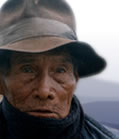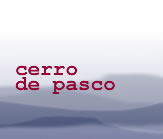This interview contains good lengthy responses from the narrators. Eliseo and Isabel are married and currently have a small business in La Oroya. Eliseo is originally from San Roque, an agricultural community, and Isabel comes from a family of miners - both her father and grandfather worked in the mines.
The couple talk about their childhood, their parents’ experiences in La Oroya and their own. They went to La Oroya because Eliseo was seeking a better paid job in order to support his family.
The couple discuss their role in the struggle to improve working conditions for the miners and reduce the contamination generated by the mining industry. Eliseo talks about his role and experiences as a union leader and Isabel discusses her experience in the Committee of Housewives that supported the miners.
The couple also talk about the problems they encountered as a result of paramilitary activities, the Shining Path and harassment from the company during the privatisation process. These problems lead them to reduce their involvement in the union and to opt for the development of a family business. Finally, their main concern is their children's future and they would not like to see them become involved in mining.
|
You will need a password from Panos to view the full
transcript of the interview. To apply for a password, click here.
Once you have a password, click here to go to the beginning
of the transcript. You can also click on any section of the
breakdown of content below and go straight to the
corresponding part of the transcript.
|
| Section 1 |
Eliseo talks about his childhood: everyone was involved in agriculture; he was a very active student in primary school and had to attend school in another district.
Eliseo says his father was an active community leader and inspired him to work for his community.
|
| Section 2 |
Eliseo comments that the people from San Roque are "too Catholic".
Customs and religious festivals: The Dance of Los Negritos, faenas, the arrival of the Three Wise Men.
Followed father to work in community faenas (community, communal work) – harvesting of potatoes and barley done collectively, and then threshing using many horses. During faenas the women prepared food for the community as a demonstration of solidarity and unity among the residents. Those who do not participate in community work are sanctioned.
|
| Section 3 |
In San Roque the celebrations were primarily religious but today people are no longer as devout - now only dancing and drinking. Blames this change partly on poverty.
Legends about a hill in San Roque with many caves in it.
|
| Section 4 |
Spring water comes from this hill and is now drinkable. There are two rivers for irrigation.
Explains why he was always anxious to leave his community: residents were having too many children thus leaving very little land to be divided.
He was always anxious to have a different future.
Had financial problems to complete secondary education - must study and work.
Stresses importance of community work. His ultimate goal has always been to return to his community with capital in order to serve the community
|
| Section 5 |
Talks about his life as a secondary school student in Chupaca
Financial constraints eliminate university as an option and instead he attends a training centre where he sets up a cooperative with his classmates.
|
| Section 6 |
Describes how marriage and family responsibilities lead him to seek work in Centromin in La Oroya. Explains that like the majority of workers he only intended to stay one or two years because of the environmental problems, but so far, he has been there 19 years. Stresses that life in La Oroya demands big changes, regardless of whether one is from the countryside or the city
Isabel talks about the changes in her life and her experiences as a child. Her
grandfather and father worked for the mining company. She describes living conditions of workers in the early days
|
| Section 6-7 |
At the time when her father was working it was easy to find a job
|
| Section 7 |
Talks about the customs of Mito, her community, especially about the Huanconada – like a village council
Quechua is virtually no longer spoken among younger generations in the central highlands.
History of Mito. Isabel went to secondary school but left due to her marriage
|
| Section 8 |
Isabel talks about how it was difficult to study and fulfil household responsibilities. Her husband encourages her to study – unlike other men who would rather have their wives stay at home
Eliseo talks about his arrival in La Oroya in 1976
Nationalisation of the Cerro de Pasco Corporation, now Centromin Peru. Camps were built for seasonal workers but they live with their families in overcrowded conditions. Environmental problems: toxins, contamination
|
| Section 9 |
Action taken by workers to change inhuman working conditions - company and government ignore the worker’s complaints. Water pollution.
Changes in living conditions: initially the workers were better paid, had more benefits and the purchasing power was greater. Describes a good social life as a result of Centromin's boom, but indicates that the workers were unaware of the grave mistakes made by the company
|
| Section 10 |
Initial relationship with the company: positive but some conflicts
Isabel discusses the role of women in the struggle against the company – supported the men.
Eliseo was elected sectional delegate for the labour union
|
| Section 11 |
Eliseo's union activities: involved in campaigning about the health problems and accidents resulting from mining work. Talks about the marginalisation of workers and housing problems, he worked to reach equality amongst workers but company tried to manipulate individuals.
|
| Section 12 |
Talks about the company's lack of respect for workers: they were aware of the need to improve technology and productivity and says all suggestions were ignored by the company. Asserts that the main problem in Centromin was corruption which brought about the crisis - blames government for turning a blind eye.
The recent privatisation programme, attack on the union leaders by the authorities and his experience as a union leader
|
| Section 13 |
Eliseo talks about he was made a victim of the company's and the government's power: informers spread rumours about him until he was expelled from the union. Great distrust amongst the workers. Isabel talks about how the family was threatened and harassed. She describes her involvement in the struggle to help the workers – untied group of wives in the Support Committee
|
| Section 14 |
Isabel explains how they survived when the company stopped paying Eliseo his wages for an entire year. Talks about how the workers requested the support and help of the women. Participation has been reduced but the struggle continues and solidarity remains. Eliseo explains that the conditions for union work are more peaceful again.
|
| Section 15 |
Murder of union leaders and involvement of paramilitary groups, as well as the Shining Path.
Talks about their family business and the financial need to concentrate on that.
|
| Section 15-16 |
Eliseo talks about the future he wants for his children and his own future with his business. He does not want his children to get into mining work.
He got a flavour for business when he was a child and is ambitious about this.
|
| Section 17-18 |
Eliseo says he no longer wants to return to San Roque, his community of origin, because there is no future for the children there in terms of education
|
| Section 18 |
Explains the tradition of commerce in Mantaro Valley and the need for miners to be ready to do other things as so many are fired and face problems.
Isabel hopes for a better future for them and their children.
|


